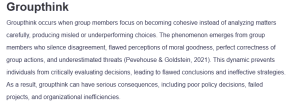Groupthink
Groupthink occurs when group members focus on becoming cohesive instead of analyzing matters carefully, producing misled or underperforming choices. The phenomenon emerges from group members who silence disagreement, flawed perceptions of moral goodness, perfect correctness of group actions, and underestimated threats (Pevehouse & Goldstein, 2021). This dynamic prevents individuals from critically evaluating decisions, leading to flawed conclusions and ineffective strategies. As a result, groupthink can have serious consequences, including poor policy decisions, failed projects, and organizational inefficiencies.
Groupthink is characterized by several key signs that hinder critical thinking and decision-making. An uncanny sense of invulnerability makes the group members think their decisions are flawless, which leads to risky behavior and actions without adequate review. Combined rationalization occurs when the group collectively dismisses opposing evidence or concerns, reinforcing flawed decisions rather than evaluating alternatives objectively.
Self-censored speech results when people are too afraid to speak their minds and voice doubts or disagreements, lest they start a fight or be rejected, which diminishes viewpoint diversity. Additionally, dissenters commonly find themselves pressured to go along with what the rest of the group believes, discouraging independent thought and reinforcing conformity. These signs cause poor group decision-making and a lack of thorough examination.
To avoid groupthink, organizations should keep communication channels open and encourage all members to share their ideas and problems without fearing rejection. The appointment of a critical evaluator pushes against preconceptions. It objectively analyzes proposals, which helps to mitigate biased decision-making alternatively, creating a working environment where the room is open to different views, which, in turn, will lead to healthy discussions about the outcome of the task at hand and more rounded and better solutions. These measures could strengthen independent thinking, prevent degenerate decisions, and establish a critical thinking and innovativeness culture.
In 1961, the Bay of Pigs invasion exemplified groupthink as a historical occurrence. President John F. Kennedy received approval from the U.S. government to conduct secret operations to remove Cuban leader Fidel Castro from power (Marquardt & Tiede2023). Officials implementing the Bay of Pigs planning dismissed multiple warnings that Cuban military power was more substantial than anticipated and that residents would not back the attack despite their warnings. The military operation turned out to be disastrous, thus damaging U.S. trust and credibility in the eyes of the world.
Group members operating under high pressure felt invulnerable to error, resulting in incorrect logical conclusions and tactical execution abnormalities. The failure of the invasion highlighted the dangers of ignoring dissenting opinions and failing to assess potential risks critically. As a result, the U.S. government reassessed its decision-making processes to prevent similar strategic miscalculations in the future.
A personal example of groupthink occurred in a school group project where my team had to develop a policy recommendation on international trade. All group members showed enthusiasm for aggressive free-trade policies even though they neglected potential negative aspects. The group shot down economic concerns about equality and worker rights from a single member.
Some members and I refused to question the group’s decisions because we wanted to preserve unity. The insufficient depth in our group presentation led to feedback that pointed out our lack of critical analysis in the assembly.
In conclusion, groupthink has destructive consequences and may lead to low-quality decisions, non-compliance projects, and reduced organizational efficiency. However, individuals and groups can prevent its rise by recognizing its main signs, such as overconfidence, rationalization, stifled criticism, and pressure. Using the example of the Bay of Pigs disaster and a school case of a group project demonstrated the threats of groupthink and its unopposed nature.
Avoiding groupthink includes open communication lines, selection of critical evaluators, and actively promoting diverse perspectives. Empowering people to think freely and critically results in better decisions and more substantial outcomes.
References
Marquardt, M. J., & Tiede, B. (2023). Leading with questions: How leaders discover powerful answers by knowing how and what to ask. John Wiley & Sons.
Pevehouse, J. C. W., & Goldstein, J. S. (2021). International relations, Brief edition (8th ed.). Pearson.
ORDER A PLAGIARISM-FREE PAPER HERE
We’ll write everything from scratch
Question
- The authors define groupthink as “the tendency of groups to validate wrong decisions by becoming overconfident and underestimating risks.” Provide an explanation for groupthink that incorporates content from the textbook and Week 5 PowerPoint presentation (e.g., indicators and solutions). Use two examples (two historical or one historical and one personal) to demonstrate your understanding of groupthink.
Groupthink
Class textbook: Pearson e-text for international relations, Brief Edition, 8e
Authors(s) Pevehouse Jon, Goldstein Joshua ISBN-13 9780137528325 format, CITE, Pearson+ e-Textbook


